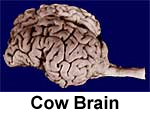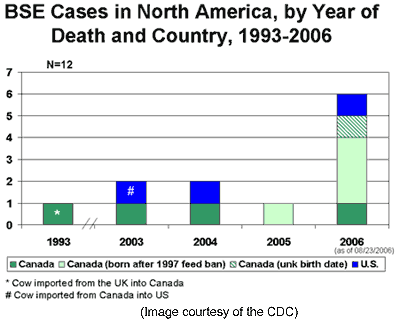Neuroscience For Kids
Mad Cow Disease
April 12, 2007
By Dr. Linda L. Walsh
Dept. of Psychology, University of Northern Iowa
 News Flash: Beef imports banned
amid Mad Cow Disease scare!
News Flash: Beef imports banned
amid Mad Cow Disease scare!
Such headlines arise when there is concern that cattle in some
region may have been exposed to Mad Cow Disease. What exactly is Mad Cow
Disease and why should humans care about sick cows? Let's take a closer
look at this disease as well as some related ones.
What is Mad Cow Disease?
Mad Cow Disease (or Bovine Spongiform Encephalopathy) is an infectious disease of cattle transmitted not by a virus or bacteria, but by an abnormal form of a type of protein called a prion. The disease is associated with progressive damage to the brain accompanied by changes in motor control and behavior. The affected parts of the brain develop a spongy appearance.
How Do Cows Catch This Disease?
 Prions are not transmitted through the air by a cough or a sneeze or other
casual contact. They can be transmitted, however, by consuming or directly
contacting infected tissues. Eating infected tissue? How would that
happen? One theory that has gained fairly wide acceptance is that Mad Cow
Disease first developed when cattle were given feed containing meat and
bone meal from sheep infected with a similar prion disease called
scrapies. The cattle developed worsening problems with movement and
balance as well as erratic behavior. The abnormal prions seem to be nearly
indestructible, able to pass on the disease even after the commercial
processing of the feed, cooking, boiling, or even irradiation. Once cattle
were infected then byproducts from these cattle, also used in animal feed,
could also transmit the disease.
Prions are not transmitted through the air by a cough or a sneeze or other
casual contact. They can be transmitted, however, by consuming or directly
contacting infected tissues. Eating infected tissue? How would that
happen? One theory that has gained fairly wide acceptance is that Mad Cow
Disease first developed when cattle were given feed containing meat and
bone meal from sheep infected with a similar prion disease called
scrapies. The cattle developed worsening problems with movement and
balance as well as erratic behavior. The abnormal prions seem to be nearly
indestructible, able to pass on the disease even after the commercial
processing of the feed, cooking, boiling, or even irradiation. Once cattle
were infected then byproducts from these cattle, also used in animal feed,
could also transmit the disease.
How Common is Mad Cow Disease?
The largest outbreak occurred in the United Kingdom in 1993, when the cause and transmission of Mad Cow Disease was just beginning to be understood. About 185,000 cases in cattle have been identified in the U.K. and surrounding countries since then. Only about a dozen cases have been identified in North America in that time period. It is hoped that changes in the use of animal byproducts in cattle feed will prevent further outbreaks of the disease.

Can Other Species Catch Prion Diseases?

Prion diseases (or "transmissible spongiform encephalopathies") similar to Mad Cow Disease have been discovered in a wide variety of species: goats, sheep, mink, squirrels, elk, deer, cats, rhesus monkeys, lemurs, cheetahs, puma, lions, tigers, and a variety of exotic zoo ungulates like kudu and elands. Even humans can develop a prion disease known as Creutzfeldt-Jakob Disease.
Creutzfeldt-Jakob Disease - A Prion Disease in Humans
 Creutzfeldt-Jakob Disease (CJD) is normally a rare, but fatal brain
disorder. In the United States, typically only 200-300 new cases are
identified each year, mostly in individuals in their late fifties or
older. About 5-15% of these cases are familial; a mutated gene leading to
the production of abnormal prions is passed on from generation to
generation. Most other cases are considered "sporadic CJD" for which the
cause is not yet known. There may be a long incubation period before the
first signs of CJD, but once symptoms appear the disorder usually
progresses at a rate much faster than other dementias such as Alzheimer's
disease. The spongiform changes in brain tissue cause the brain to shrink
and can impair all the various functions of brain - motor coordination,
memory, judgment, personality, speech, vision, and, eventually, basic
life-sustaining processes.
Creutzfeldt-Jakob Disease (CJD) is normally a rare, but fatal brain
disorder. In the United States, typically only 200-300 new cases are
identified each year, mostly in individuals in their late fifties or
older. About 5-15% of these cases are familial; a mutated gene leading to
the production of abnormal prions is passed on from generation to
generation. Most other cases are considered "sporadic CJD" for which the
cause is not yet known. There may be a long incubation period before the
first signs of CJD, but once symptoms appear the disorder usually
progresses at a rate much faster than other dementias such as Alzheimer's
disease. The spongiform changes in brain tissue cause the brain to shrink
and can impair all the various functions of brain - motor coordination,
memory, judgment, personality, speech, vision, and, eventually, basic
life-sustaining processes.
Variant Creutzfeldt-Jakob Disease
 The spread of Mad Cow Disease was associated with an unusual increase
in cases of CJD. Unlike sporadic CJD, these cases appeared to be linked to
the consumption of beef from cattle with undiagnosed BSE and involved
individuals much younger than the typical CJD patient. This new form of
CJD became known as "variant Creutzfeldt-Jakob Disease" (vCJD). Because
appearance of the symptoms of CJD is sometimes delayed, additional CJD
cases related to the Mad Cow Disease outbreak in the United Kingdom may
surface in the future.
The spread of Mad Cow Disease was associated with an unusual increase
in cases of CJD. Unlike sporadic CJD, these cases appeared to be linked to
the consumption of beef from cattle with undiagnosed BSE and involved
individuals much younger than the typical CJD patient. This new form of
CJD became known as "variant Creutzfeldt-Jakob Disease" (vCJD). Because
appearance of the symptoms of CJD is sometimes delayed, additional CJD
cases related to the Mad Cow Disease outbreak in the United Kingdom may
surface in the future.
Treatment
No treatment that can cure or prevent the progression of Creutzfeldt-Jakob Disease has yet been discovered. Currently treatment focuses on alleviating symptoms and making an individual with CJD as comfortable as possible.
 Click on a word to hear
how it is pronounced:
Click on a word to hear
how it is pronounced:
Prion | Bovine Spongiform Encephalopathy | Creutzfeldt-Jakob Disease
For more information about Mad Cow Disease and Creutzfeldt-Jakob Disease, visit the following Web sites:
- Mad Cow Disease Detected for First Time in United States - Neuroscience for Kids, December 31, 2003
- Bovine Spongiform Encephalopathy or Mad Cow Disease Information from the Centers for Disease Control
- Mad Cow Disease and Variant Creutzfeldt-Jakob Disease from E-Medicine
- The Emergence of BSE and Related Diseases from CDC's Emerging Infectious Diseases
- Bovine Spongiform Encephalopathy (BSE) from the FDA
- Creutzfeldt-Jakob Disease Fact Sheet from the National Institute of Neurological Disorders and Stroke (NINDS)
- Variant Creutzfeldt-Jakob Disease from the World Health Organization
- Classic CJD from the Centers for Disease Control
- Creutzfeldt-Jakob Disease from the MayoClinic.com
- MedlinePlus Medical Encyclopedia: Creutzfeldt-Jakob Disease
- MedlinePlus: Additional Resources on Creutzfeldt-Jakob Disease
Copyright © 1996-2020, Eric H. Chudler, University of Washington
